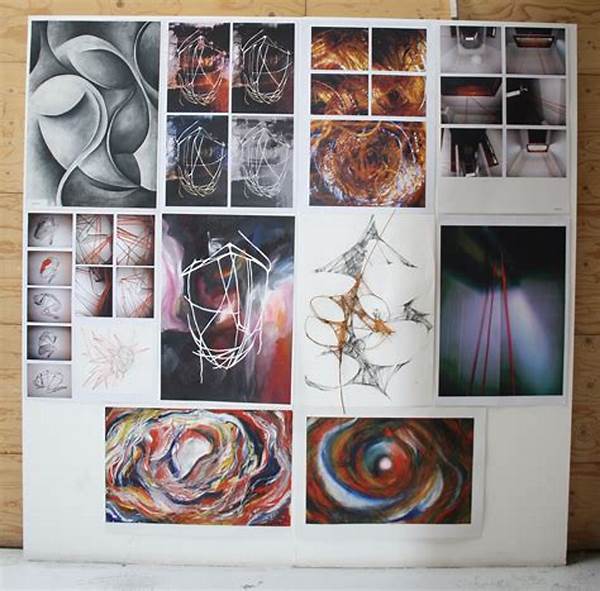Creating a compelling art portfolio requires a blend of creativity and technical skills, particularly in photography. As an artist, capturing your work through photography can enhance its presentation and impact. Mastering photography techniques for art portfolio brings out the best in your creations, allowing them to shine and captivate your audience. This article delves into some effective techniques to help you photograph your artwork with finesse.
Read Now : Basics Of Fantasy Digital Art
Understanding Light and Composition
When discussing photography techniques for art portfolio, understanding light and composition is paramount. Proper lighting can make a significant difference in highlighting the textures and colors of your artwork. Experiment with both natural light and studio lighting to see which best suits your pieces. Additionally, composition is key; consider the rule of thirds to create well-balanced and visually appealing images. By thoughtfully arranging elements within the frame, your art will not only be adequately represented but also engage viewers more effectively.
Embrace shadows and highlights to add depth and dimension to your images. Shadows can create intriguing patterns or outlines, enhancing the mood of your artwork. Moreover, being attentive to the background can prevent distractions from the artwork itself. A neutral or complementary background helps in keeping the focus on your art piece. Investing time to get these elements right can dramatically improve the quality of your photographic portfolio.
Finally, don’t overlook the power of perspective. Angles and viewpoints can completely change the way a piece of art is perceived. Use this to your advantage by photographing your art from different perspectives. This approach not only highlights various aspects of your work but also adds dynamism to your portfolio, showcasing your art in a multifaceted manner.
Essential Photography Techniques
1. Macro Photography: Capture intricate details of your artwork by employing macro photography. This technique allows viewers to appreciate the finer elements that might go unnoticed otherwise, making it an essential tool in photography techniques for art portfolio.
2. Color Accuracy: Maintaining true color representation in your photographs is crucial, especially for showcasing artwork. Employ white balance adjustments to guarantee that the colors in your images match those of the physical artwork.
3. Editing Software: Utilize editing software to enhance photos subtly but effectively. This includes adjusting contrast, brightness, and sharpness, ensuring your artwork is depicted in the best light while preserving its authenticity.
4. Framing and Cropping: Properly framing and cropping images can eliminate unnecessary distractions and focus the viewer’s attention on the art piece. This approach is fundamental in photography techniques for art portfolio.
5. Use of Tripods: For stability and precision, use a tripod. It ensures sharp images by reducing camera shake, especially in lower light conditions or when working with longer exposure times.
Building Your Photography Portfolio
The next stage in mastering photography techniques for art portfolio involves effectively building your portfolio. It is important to curate your images to best represent your artistic vision. Consider the flow of your portfolio, ensuring each photograph transitions smoothly to the next. Your aim should be to keep the viewer captivated and interested throughout the presentation.
Diversity in your portfolio can also be a great advantage. By showcasing a range of styles and subjects, you demonstrate your versatility as an artist. However, maintaining a consistent theme or style can also be powerful, as it establishes your identity and viewpoint. Whether opting for diversity or consistency, balance is key to a successful presentation of photography techniques for art portfolio.
Organizational aspects, like sequencing and transitions, also play a crucial role. Choose an organizational structure that tells a story or guides the viewer through your unique perspective. Thoughtful layout and design can both highlight your artistic narrative and enhance the presentation of your work, creating a compelling visual experience.
Read Now : Intellectual Property For Artists
Advanced Techniques and Tips
When refining your photography techniques for art portfolio, consider exploring more advanced techniques. These can include using HDR (High Dynamic Range) imaging to capture a wider range of light and detail in your photographs. This is particularly valuable when working with high-contrast scenes. Try panoramic photography for large pieces of artwork, allowing your audience to experience the entirety of a piece in a single image.
Engaging in continuous learning and experimentation is also crucial. Stay updated with the latest in photographic technology and techniques, as this will enable you to keep your portfolio dynamic and innovative. Seek feedback from peers and mentors within the art community to gain insights and potentially discover areas for improvement.
Don’t underestimate the power of storytelling in photography. Each photograph in your portfolio should communicate a part of your artistic journey. This narrative approach engages viewers by creating connection and meaning. Integrating these advanced techniques, coupled with storytelling, can elevate your photography techniques for art portfolio, resulting in a collection that is both captivating and professionally polished.
Presentation Techniques
The presentation of your portfolio is as critical as the images themselves. Consider how your portfolio will be viewed: digitally, in print, or at exhibitions. Each format presents its own set of challenges and opportunities. For digital formats, ensure images are optimized for web viewing, maintaining high quality while ensuring fast loading times.
Printed portfolios require meticulous attention to detail, from paper quality to binding style. Invest in high-quality printing services to ensure your artwork is faithfully represented. If showcasing at an exhibition, plan the arrangement of your pieces thoughtfully, considering both aesthetic appeal and viewer engagement.
Remember, the context in which your portfolio is presented can greatly affect perception. Tailor your photography techniques for art portfolio presentation according to the audience and setting, ensuring your work resonates and leaves a lasting impression. Experiment with various formats and observe what garners the most effective response from viewers.
Conclusion
In summary, mastering photography techniques for art portfolio is an invaluable skill for artists aiming to present their work in the most impactful way. From understanding the nuances of light and composition to embracing advanced techniques, each aspect contributes significantly to the quality of your portfolio. A well-curated and thoughtfully presented collection can enhance the perception of your art, reinforcing its value.
Continue to refine your skills, and remain open to learning new techniques and embracing technological advancements. This ongoing development will ensure that your portfolio remains current and continues to resonate with a wide audience. Investing in the right techniques and strategies not only showcases your art brilliantly but also reflects your dedication and professionalism as an artist.



